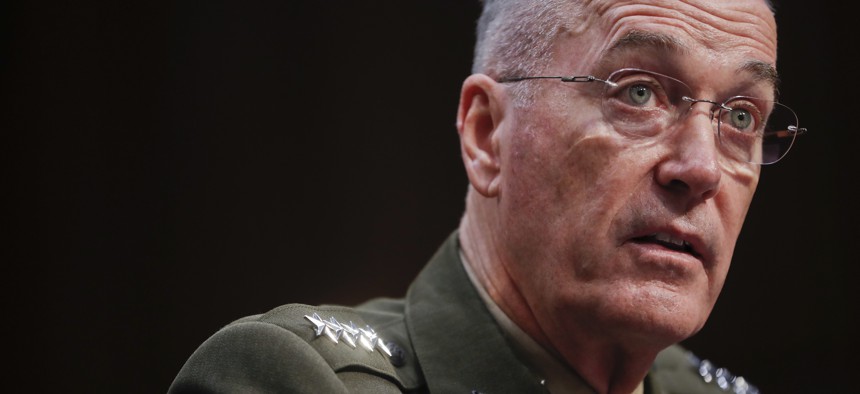
Joint Chiefs Chairman Marine Corps Gen. Joseph Dunford testifies before the Senate Committee on Armed Services on Capitol Hill in Washington, Tuesday, Sept. 26, 2017, to consider his reappointment. Martinez Monsivais/AP
Dunford: Six Months From Now, ISIS Will Have ‘Less Credibility’
But they — and four other major threats to the U.S. — aren’t going anywhere, the Joint Chiefs chairman says.
America’s top military officer is “cautious” about giving timelines for the war against the Islamic State — but half a year from now, he predicts, operations against the extremist group’s last urban stronghold in Syria will have wrapped up.
“Our partners will have completed operations in Raqqa and we’ll be well on our way to going after the external operations capabilities and the media capability of ISIS that remains in the middle of the Euphrates River valley,” Gen. Joseph Dunford told lawmakers Tuesday. “And we’ll also be supporting our Iraqi Security Forces partners on the east side of the border to better secure the border between Iraq and Syria.”
In short, he predicts more of the significant progress the U.S.-led international coalition has made in Iraq and Syria over the last year and a half, Dunford said during a hearing on his confirmation for a second term as the chairman of the Joint Chiefs of Staff.
Having liberated ISIS’ previous stronghold of Mosul, “the Iraqi Security Forces are on a pretty good trajectory right now to clear out ISIS” from the group’s remaining holdouts, Dunford said.
Related:
Mosul: What the Decade’s Largest Battle Says About the Future of War
Six months from now, he said, “we’ll have continued to degrade, most importantly, their external operations capability: the ability they have to plan and conduct external operations. I think we’ll have undermined their narrative; they will increasingly not be able to say there’s a physical caliphate in existence. I think that’ll have an impact on their recruiting. We’ve already seen the numbers drop, the numbers of individuals who are inspired to join the ISIS movement.”
And though Dunford said a long-term U.S. presence in Iraq is necessary to solidify the security situation, the Pentagon and regional partners are thinking post-caliphate. That has promising implications elsewhere: The intelligence assets so heavily used in the skies over U.S. Central Command’s area of responsibility are in high demand to monitor other, worsening, threats. Part of the reason the U.S. intelligence community had difficulties monitoring North Korea’s rapidly developing nuclear capabilities was a simple lack of available assets, Dunford admitted.
“Certainly, over the last 18 months, we have increased our collection against North Korea, but for a long period of time, we had decreased our collection against North Korea because of competing demands elsewhere in the world,” he told Sen. Jim Inhofe, R-Okla.
The Defense Intelligence Agency recently concluded that North Korea will have a nuclear-tipped intercontinental ballistic missile by the end of 2018 — a date sooner than previous assessments. But the specific date isn’t the point, according to Dunford.
“Whether it’s three months or six months or 18 months, it is soon,” he said. “And we ought to conduct ourselves as though it is just a matter of time — and a matter of very short time — before North Korea has that capability.”
Pyongyang tested an ICBM in July — sooner than many observers and members of the U.S. national security sphere expected. The regime again surprised the world with the power of its sixth nuclear test in August. Dunford said U.S. missile defenses are currently sufficient to defend against that threat, but may not keep pace as North Korea’s arsenal expands.
“As the capacity of the threat increases — that is the size, not just the lethality, not just that North Korea can reach us, but the number of missiles they possess that can reach us — what we need to be concerned about is ensuring our ballistic missile defense capability keeps pace with that,” he told Sen. Mazie Hirono, D-Hawaii.
Related: Hawaii Needs Better Missile Defense Radars, Pacific Commander Says
Political rhetoric and the recent escalatory language exchanged between President Donald Trump and North Korean leader Kim Jong-Un highlight the threat for the American public — and it is the most urgent one facing the U.S., Dunford said. But two other nations in the classic four-plus-one hierarchy worry him as much if not more: Russia and China.
Today, “in terms of overall military capability, I believe Russia poses the great threat because of the nuclear, cyber, electronic warfare and the activity we’ve seen in Crimea and Ukraine,” he said. But within the next decade, China could surpass Russia. “If I look out to 2025, and I look at the demographics and the economic situation, I think China probably poses the greatest threat to our nation.”
While discussing these threats and others, Dunford repeatedly said the U.S. military’s ability to deter and defend against these potential adversaries will be limited if it doesn’t receive sufficient and predictable funding from Congress — a common refrain in Armed Services Committee hearings, from lawmakers and Pentagon officials alike. What did Dunford say would be sufficient? A 3 to 7 percent annual increase in the military’s budget.
“We looked at the capabilities of Russia and China today, we looked at the trajectory that they are on for capability development, we looked at where we are and what investments we need to have to maintain a competitive advantage on those near-peer competitors,” he said. “We will have to fundamentally rework the strategy if we are unable to build the capabilities and capacities to deal with those peer competitors.”
That would mean changing base assumptions about what level of security the U.S. can provide itself and the world, Dunford warned: “I wouldn’t assume access to space and all that that means for our economy and military capability. I wouldn’t assume our ability to protect networks — both for commercial activity and for military activity. I wouldn’t assume our ability to deal with the growing electronic warfare threat of our adversaries. And I wouldn’t assume a capability to deal with the growing ballistic and cruise missile threat of our adversaries unless we maintain pace with capability development. Those would be bad assumptions.”
